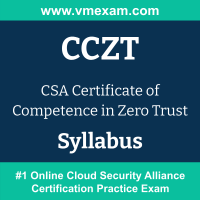 The Cloud Security Alliance CCZT exam preparation guide is designed to provide candidates with necessary information about the CCZT exam. It includes exam summary, sample questions, practice test, objectives and ways to interpret the exam objectives to enable candidates to assess the types of questions-answers that may be asked during the CSA Certificate of Competence in Zero Trust (CCZT) exam.
The Cloud Security Alliance CCZT exam preparation guide is designed to provide candidates with necessary information about the CCZT exam. It includes exam summary, sample questions, practice test, objectives and ways to interpret the exam objectives to enable candidates to assess the types of questions-answers that may be asked during the CSA Certificate of Competence in Zero Trust (CCZT) exam.
It is recommended for all the candidates to refer the CCZT objectives and sample questions provided in this preparation guide. The Cloud Security Alliance CCZT certification is mainly targeted to the candidates who want to build their career in Fundamentals domain and demonstrate their expertise. We suggest you to use practice exam listed in this cert guide to get used to with exam environment and identify the knowledge areas where you need more work prior to taking the actual CSA Certificate of Competence in Zero Trust exam.
Cloud Security Alliance CCZT Exam Summary:
| Exam Name | CSA Certificate of Competence in Zero Trust (CCZT) |
| Exam Code | CCZT |
| Exam Price | $175 USD |
| Duration | 120 minutes |
| Number of Questions | 60 |
| Passing Score | 80% |
| Recommended Training / Books | CCZT Training |
| Schedule Exam | Cloud Security Alliance |
| Sample Questions | Cloud Security Alliance CCZT Sample Questions |
| Recommended Practice | CSA Certificate of Competence in Zero Trust (CCZT) Practice Test |
Cloud Security Alliance CCZT Syllabus:
| Section | Objectives |
|---|---|
| Introduction to Zero Trust Architecture |
- Context of ZTA
- Definitions, Concepts, & Components of ZT
- Objectives of ZT
- Benefits of ZT
- Planning Considerations for ZTA
- Implementation Options of ZTA
- ZT Use Cases
|
| Introduction to Software-Defined Perimeter |
- SDP History, Benefits, & Concepts
- Traditional Architecture Issues & SDP Solutions
- Core Tenets, Underlying Technologies, & Architecture
- The Basics of SDP Deployment Models
|
| Zero Trust Strategy |
- Levels of Strategy
- Zero Trust Drivers & Buy-In
- Tactics for Zero Trust
- Zero Trust & Operations
|
| Zero Trust Planning |
- Starting the Zero Trust Journey
- Planning Considerations
- Scope, Priority, & Business Case
- Gap Analysis
- Define the Protect Surface & Attack Surface
- Document Transaction Flows
- Define Policies for Zero Trust
- Developing a Target Architecture
|
| Zero Trust Implementation |
- Continuing the ZT Journey
- ZT Project Implementation Considerations
- Implementation Preparation Activities
- ZT Target Architecture Implementation
|
